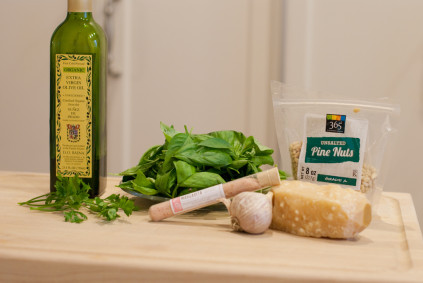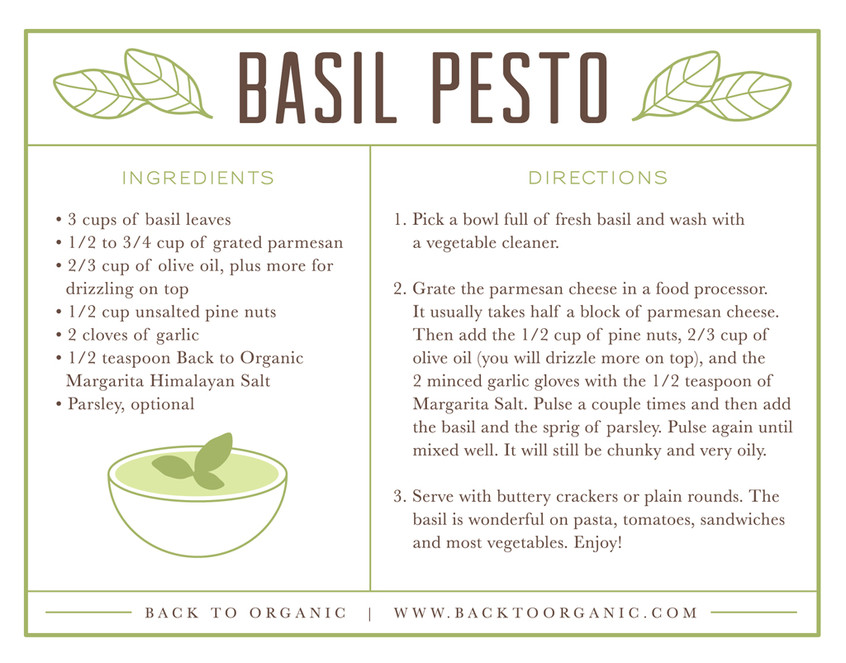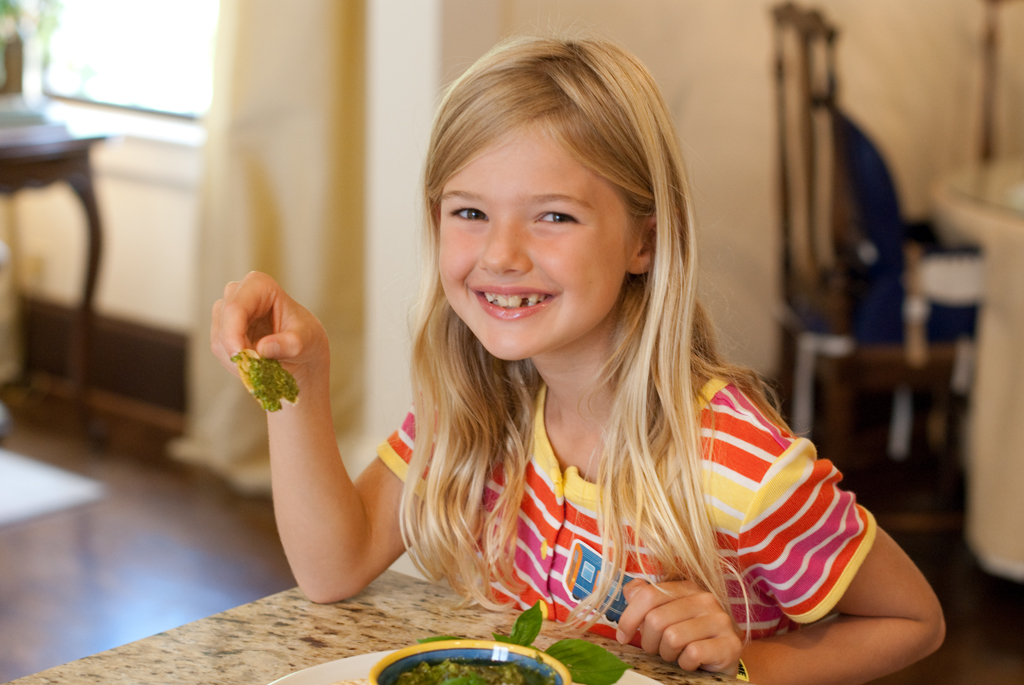Pesto is one of our favorite foods and luckily, it is very good for us too. Basil is rich in vitamins, can protect our bodies from free radical damage, has anti-bacterial properties, and is a natural anti-inflammatory. All things we need. Plus, the pine nuts contain vitamin E, manganese, and B vitamins to strengthen our muscles as well as improve our skin.

Pine nuts are a healthy fat so you can feel good about indulging in this pesto. Pine nuts trigger the release of an enzyme that suppresses your appetite so you will feel satisfied after this power food.
I use a lot of olive oil in my pesto since I add it to pasta and love to eat it as a dip with crackers and fresh vegetables. You can cut it by half if you like a chunkier version. In addition, this recipe makes a lot of pesto. If you are just using it as a dip, then cut the recipe in half. You can follow this recipe on Food Network but add more basil. Instead of 2 cups of fresh basil leaves, I use 3 cups. I have plenty of basil in the garden so it is easy for me to add more.
I highly recommend you grow your own basil plants instead of buying the organic leaves in a small pack. Basil is very easy to grow from seed. Sprinkle fresh compost over the seeds and they grow like weeds. I have many containers of fresh basil around my yard. The herb loves heat so it is flourishing right now.

Directions
1) Pick a bowl full of fresh basil and wash with Rebel Green or another vegetable cleaner.
2) Grate the parmesan cheese in a cuisinart. I used half of the block above. Then add the 1/2 cup of pine nuts, 2/3 cup of olive oil (you will drizzle more on top), and the two medium garlic gloves with the 1/2 teaspoon of Margarita Salt. Pulse a couple times to mince the garlic and then add the basil and the sprig of parsley. Make sure you packed in the basil when you measured it. Add more if you wish. Pulse again until mixed well. It will still be chunky and very oily. If it is too garlicky, add more parmesan cheese.
3) Serve with buttery crackers or plain rounds. The basil is wonderful on pasta, tomatoes, sandwiches and most vegetables. Enjoy!

Why you want to eat this!
- Basil is rich in vitamin K, iron, vitamin A, fiber, manganese, magnesium, and calcium as well as contains flavonoids and volatile oils. These flavonoids protect your cellular structures and DNA from damage by radiation and free radicals. The volatile oils in basil act as an anti-bacterial. Basil can fight certain bacteria which has become resistant to antibiotics. In addition, basil is a powerful anti-inflammatory because it can block an enzyme in the body called COX which is the same enzyme aspirin, ibuprofen and acetaminophen block to relieve pain. It may help rheumatoid arthritis and inflammatory bowel disorders. It also may improve your cardiovascular health, asthma, and osteoarthritis due to the beta-carotene. Make sure you buy organic basil to ensure it has not been irradiated which significantly reduces the beta-carotene and vitamin C. Read more.
- Margarita Himalayan Sea Salt contains 84 trace minerals including magnesium, calcium, zinc, and potassium. It may have the ability to lower blood pressure and cleanse toxins from the body. The organic lime zest provides you Vitamin C.
- ?Pine nuts are rich in calories, vitamins, antioxidants and minerals and packed with numerous health promoting phyto-chemicals.
- The high caloric content of pines comes from their fats. However, the nuts are especially rich in mono-unsaturated fatty acids like oleic acid (18:1 undifferentiated fat) that helps to lower LDL or ?bad cholesterol? and increase HDL or ?good cholesterol? in the blood. Research studies suggest that Mediterranean diet, which is rich in monounsaturated fatty acids, helps to prevent coronary artery disease and strokes by favoring healthy blood lipid profile.
- Pine or cedar nuts contain essential fatty acid (?-6 fat) pinolenic acid. Recent research has shown its potential use in weight loss by curbing the appetite. Pinolenic acid causes the triggering of hunger suppressant enzymes cholecystokinin and glucagon-like peptide-1 (GLP-1) in the gut. In addition, pinolenic acid may have LDL-lowering properties by enhancing hepatic LDL uptake.
- Like almonds, pines are an excellent source of vitamin E; contain about 9.33 mg per 100 g (about 62% of RDA). Vitamin E is a powerful lipid soluble antioxidant, required for maintaining the integrity of cell membrane of mucus membranes and skin by protecting it from harmful oxygen free radicals.
- Furthermore, like almonds and peanuts, pines are free from gluten and therefore are a popular ingredient in the preparation of gluten free food formulas. Such formula preparations are in fact healthy alternatives in people with wheat food allergy and celiac disease.
- Pinenuts are excellent source of B-complex group of vitamins such as thiamin, riboflavin, niacin, pantothenic acid, vitamin B-6 (pyridoxine) and folates. These vitamins functions as co-factors for enzymes during cellular substrate metabolism.
- Furthermore, pine nuts contain healthy amounts of essential minerals like manganese, potassium, calcium, iron, magnesium, zinc and selenium. At 8.802 mg per 100 g (about 383% of daily recommended intake), pines are one of the richest sources of manganese. Manganese is an all-important co-factor for antioxidant enzyme, superoxide dismutase. It is therefore consumption of pines helps body develop resistance against infectious agents and scavenge harmful oxygen free radicals.? read more
